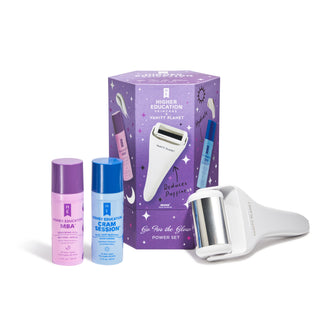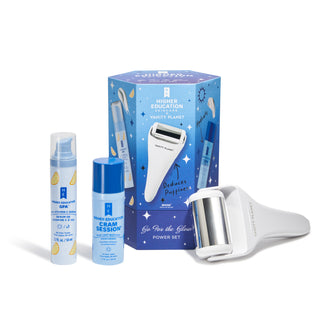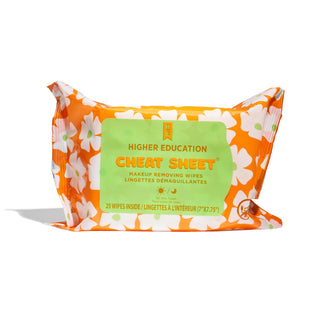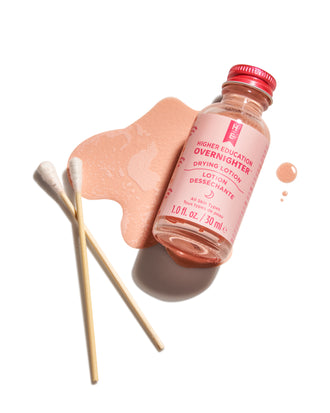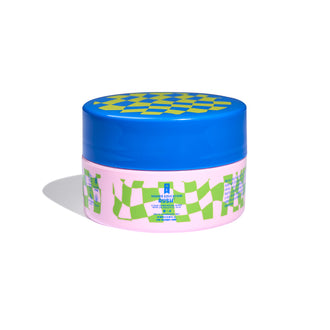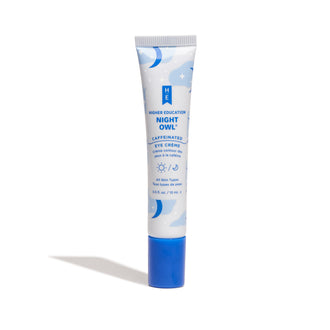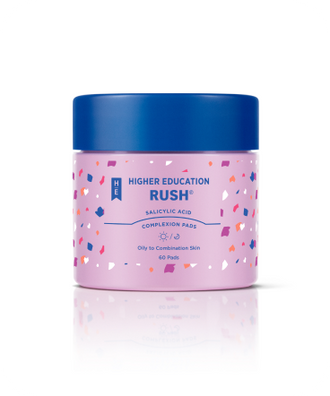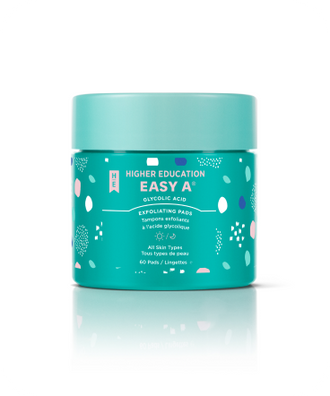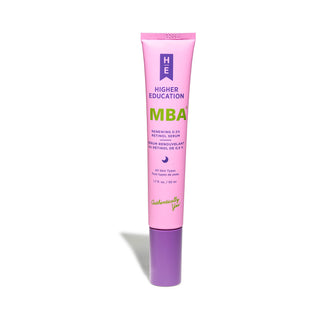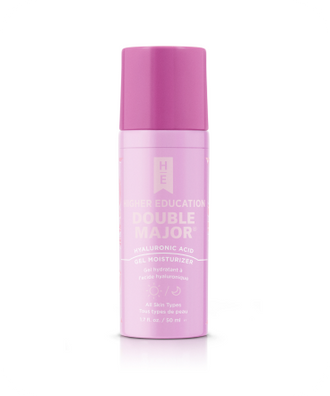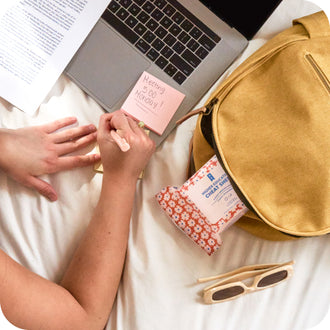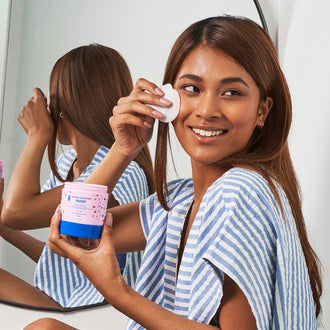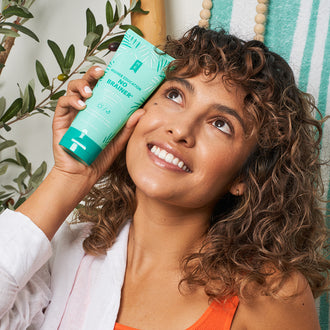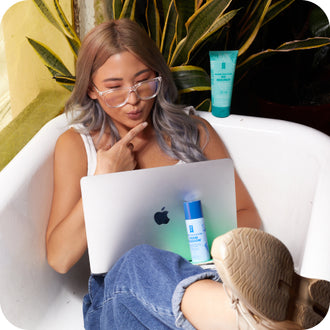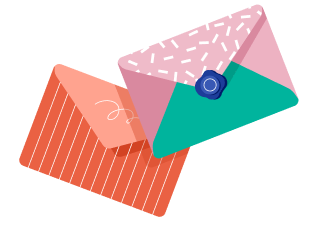
Class is in session! Welcome to Retinol 101: a crash course for beginners in the basics of what some dermatologists dub as one of the most effective treatments for acne, aging, fine lines and wrinkles. Retinol, baby!
Packs a powerful punch, right? One might say it is even underutilized and can, of the same token, be misused.
Retinol is considered a multi-tasking, powerhouse ingredient and is one of the most useful ingredients in a dermatologist’s bag of tricks. Once your 20s roll around and you’re sitting in your fave derm’s office: the word “retinol” tends to come up more often than not. Most dermatologists recommend beginning retinol use around the age of 20 for preventative reasons.
Sometimes people (myself included) are a bit intimidated to start implementing retinol into their skincare routine. Initially, it sounds pretty daunting, right? I remember growing up and gawking in my mother’s master bathroom as she applied her skincare and beauty products (oof, I was a little pest). Occasionally, she would even let me try some of her new Estee Lauder moisturizer or Chanel rouge.
I vividly recall her preventing me from trying one specific product in her vanity, a product she called “the serum you will use when you get older” otherwise known as a retinol-based product. Boy, did ‘older’ come fast! I had a TON of questions about retinol at first, but once my dermatologist was able to break down this intimidating ingredient, it didn’t seem so intimidating anymore.
I sat down with Dr. Susan Cox, our all-star dermatologist, to dive deeper into this miracle ingredient and how exactly it benefits the skin. I consulted with Dr. Cox about all the burning questions I had as I started to incorporate retinol into my skincare routine. Consider this your beginner’s guide to retinol use. Let’s get skin deep!
Q: So, Dr. Cox, what is retinol?
A: Retinol is an over-the-counter version of a Retinoid (various forms of the molecule vitamin A) that stimulates collagen production and encourages cell turnover to reveal your most youthful layer of skin. Retinol is a derivative of vitamin A, which is essentially one of the body’s key vitamins in boosting cell turnover. When used on the skin, retinol treats acne, repairs sun damage, creates a more even-toned complexion and has some serious anti-aging effects. Retinol has a much stronger potency than many other skincare ingredients and is the strongest form of topical vitamin A available without a prescription.
Q: Why should I, or anyone else, add retinol into my skincare regimen?
A: Retinol can do wonders for your skin. Most all of us have sustained damage to our cells from sun and environmental aggressors and pollutants. Retinol helps to repair this DNA damage caused to our cells.
Retinol also helps to treat acne tremendously by increasing exfoliation and “unclogging” pores. Clogged pores are the basis of acne causation; that being said, retinol can act as that “holy-grail” ingredient you’re looking for when treating acne. It helps to brighten skin, lighten brown spots and reduce scars from acne breakouts by increasing cell turnover, exfoliation and slowing the production of pigmentation. Retinol works overtime as an anti-aging powerhouse by encouraging the formation of collagen and new blood vessels that would normally decrease with age.
Q: How do you use it?
A: Retinol is best when included in your pre-bedtime ritual. After you wash your face at night with a mild cleanser, apply about a pea-sized amount to your forehead, cheeks and chin (avoiding the area just around the eyes and the corners of the mouth, or the places where your skin is most sensitive.) A little bit goes a long way, so really massage it into your skin.
When you start using retinol, you want to be very careful. Since this ingredient is strong, you may notice some redness or light flaking of the skin, which is totally normal. If you are sensitive to the redness or light flaking, I recommend you slowly ease retinol into your routine, starting with 1x per week and gradually building up to 3-4x per week over time as your skin adjusts to this ingredient.
If you have oily, acne prone, or combination skin, you may eventually be able to use retinol nightly. But if your skin is sensitive or dry, you may stick with 3-4x per week or less for the same effects.
The best AM/PM routine is as follows:
AM
- HIGHER EDUCATION PRE-REQ® Purifying Facial Cleanser (for oily or acne prone) OR NO BRAINER® Gentle Facial Cleanser (for dry or sensitive)
- RUSH® Salicylic Acid Complexion Pads (for oily or acne prone) OR HIGHER EDUCATION EASY A® Glycolic Acid Exfoliating Pads (for dry or sensitive)
- DOUBLE MAJOR® Hyaluronic Acid Gel Moisturizer (for oily or acne prone) OR GOAL DIGGER® Soothing Gel Crème (for dry or sensitive)
- HIGHER EDUCATION SPRING BREAK® Oil-Free Sunscreen SPF 30**
PM
- HIGHER EDUCATION PRE-REQ® Purifying Facial Cleanser (for oily or acne prone) OR NO BRAINER® Gentle Facial Cleanser (for dry or sensitive)
- RUSH® Salicylic Acid Complexion Pads (for oily or acne prone) OR HIGHER EDUCATION EASY A® Glycolic Acid Exfoliating Pads (for dry or sensitive)
- DOUBLE MAJOR® Hyaluronic Acid Gel Moisturizer (for oily or acne prone) OR GOAL DIGGER® Soothing Gel Crème (for dry or sensitive)
- MBA® Renewing 0.5% Retinol Serum
**SPF is extremely important to apply daily when using retinol. Do not skip this step!
Q: What are the possible side effects when first starting to use retinol?
A: When you first begin using retinol, you may notice a few side effects:
- Increased sensitivity
- Some redness or irritation
- Dry or flaking skin
Don’t fret, as these usually disappear in a matter of weeks as your skin adapts to the ingredient and adjusts accordingly. If you are experiencing dry skin, use an oil-free moisturizer as needed.
Retinol can also increase sensitivity to the sun’s UV rays, so it is recommended to use retinol in your PM skincare routine and, again, use sunscreen daily to avoid sunburn. Environmental factors that would normally dry out skin (wind, cold, central heat) can increase the various side effects of retinol. You can combat these side effects by moisturizing daily or cutting down usage.
Retinol is an ingredient that tends to be more effective when the user builds up tolerance over time.
Q: How long should I use retinol in order to see results?
A: As a dermatologist, some of the most beautiful and stunning skin I’ve ever seen is that of patients who use retinol consistently for the long term. Although you may start to see improvements to your skin within 2-4 weeks, this is an ingredient that is meant to both treat and maintain the health of your skin over time. I encourage you to see retinol as a step in your standard skincare routine; think of it as a relationship you need to nurture for long-lasting, desired results.
Retinol has 100% changed my skin and done wonders for my acne and my overall complexion. When used properly, retinol absolutely has potential to be that transformative, skin chemistry-changing product in your skincare regimen.
For me, it really was a balancing act with retinol; I had to figure out the usage that worked for my skin through trial-and-error as everyone’s skin is different. I might go as far as to say retinol was my “gateway drug” to a long-lasting addiction to skincare.
I highly recommend consulting with your dermatologist to explore how you can incorporate retinol into your skincare routine.


